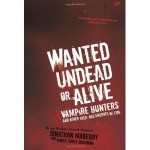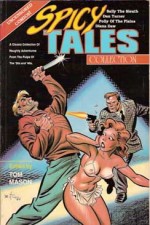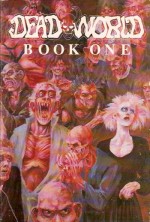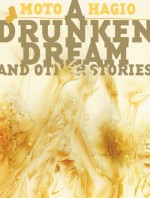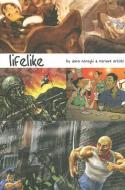
By various (DC Comics)
ISBN: 978-1-4012-0786-1
American comicbooks started slowly until the creation of superheroes unleashed a torrent of creative imitation and invented a new genre. Implacably vested in the Second World War, the Overman swept all before him (and the very occasional her) until the troops came home and older genres supplanted the Fights ‘n’ Tights crowd.
Although new kids kept up the buying, much of the previous generation also retained their four-colour habit but increasingly sought older themes in the reading matter. The war years altered the psychology of the world, and as a more world-weary, cynical young public came to see that all the fighting and dying hadn’t really changed anything their chosen forms of entertainment (film and prose as well as comics) reflected this. As well as Western, War and Crime comics, madcap escapist comedy and anthropomorphic funny animal features were immediately resurgent, but gradually another periodic revival of spiritualism and interest in the supernatural led to a wave of increasingly impressive, evocative and even shocking horror comics.
There had been grisly, gory and supernatural stars before, including a pantheon of ghosts, monsters and wizards draped in mystery-man garb and trappings (the Spectre, Mr. Justice, Sgt. Spook, Frankenstein, The Heap, Sargon the Sorcerer, Zatara, Dr. Fate and dozens of others), but these had been victims of circumstance: the unknown as a power source for super-heroics. Now the focus shifted to ordinary mortals thrown into a world beyond their ken with the intention of unsettling, not vicariously empowering, the reader.
Almost every publisher jumped on the increasingly popular bandwagon, with B & I (which became the magical one-man-band Richard E. Hughes’ American Comics Group) launching the first regularly published horror comic in the Autumn of 1948, although Adventures Into the Unknown was technically pipped by Avon who had released an impressive single issue entitled Eerie in January 1947 before launching a regular series in 1951, by which time Classics Illustrated had already long milked the literary end of the medium with adaptations of the Headless Horseman, Dr. Jekyll and Mr. Hyde (both 1943), The Hunchback of Notre Dame (1944) and Frankenstein (1945) among others.
If we’re keeping score this was also the period in which Joe Simon and Jack Kirby identified another “mature market†gap and invented the Romance comic (Young Romance #1, September 1947) but they too saw the sales potential for spooky material, resulting in the seminal Black Magic (launched in 1950) and boldly obscure psychological drama anthology Strange World of Your Dreams (1952).
The company that would become DC Comics bowed to the inevitable and launched a comparatively straight-laced anthology that nevertheless became one of their longest-running and most influential titles with the December 1951/January 1952 launch of The House of Mystery. When the hysterical censorship scandal which led to witch-hunting hearings (feel free to type Senate Subcommittee on Juvenile Delinquency, April- June 1954 into your search engine at any time… You can do that because it’s ostensibly a free country now) was curtailed by the industry adopting a castrating straitjacket of self regulatory rules HoM and its sister title House of Secrets were dialled back into rationalistic, fantasy adventure vehicles, and even became super-hero tinged split-books (With Martian Manhunter and Dial H for Hero in HoM, and Eclipso sharing space with Mark Merlin and later Prince Ra-Man in HoS).
However nothing combats censorship better than falling profits and at the end of the 1960s the Silver Age superhero boom stalled and crashed, leading to the surviving publishers of the field agreeing to loosen their self-imposed restraints against crime and horror comics. Nobody much cared about gangster titles but as the liberalisation coincided with another bump in global interest in all aspects of the Worlds Beyond, the resurrection of scary stories was a foregone conclusion and obvious “no-brainer.†Even the ultra wholesome Archie comics re-entered the field with their rather tasty line of Red Circle thrillers…
Thus with absolutely no fanfare at all issue #174, cover dated May-June 1968 presented a bold banner demanding “Do You Dare Enter The House of Mystery?†and reprinted a bunch of admittedly excellent short fantastic thrillers originally seen in House of Secrets from the heady days when it was okay to scare kids. Staring off was ‘The Wondrous Witch’s Cauldron’ (HoS #58) by an unknown writer and compellingly illustrated by the great Lee Elias, another uncredited script ‘The Man Who Hated Good Luck!’ limned by Doug Wildey and the only new feature of the issue – one which would set the tone for decades to come.
Page 13 was a trenchantly comedic feature page scripted by Editor and EC veteran Joe Orlando and cartooned by manic Hispanic genius Sergio Aragonés. It stated quite clearly that whilst the intent was to thrill, enthral and even appal it was all in the spirit of sinister fun, and gallows humour was the order of the day. The comic then concluded with a Bernard Baily tale of the unexpected ‘The Museum of Worthless Inventions’ (from #13) and concluded with the Jack Miller, Carmine Infantino & Mort Meskin fantasy fable ‘The Court of Creatures’ (a Mark Merlin masterpiece from HoS #43).
The next issue can probably be counted as the true start of this latter day revenant renaissance, as Orlando revived the EC tradition of slyly sardonic narrators by creating the Machiavellian Cain, “caretaker of the House of Mystery†and raconteur par excellence. Behind the first of a spectacular series of creepy covers from Neal Adams lurked another reprint ‘The Gift of Doom’ (from HoM #137, illustrated by George Roussos) followed by ‘All Alone’, an original, uncredited prose chiller.
After another Page 13 side-splitter, Aragonés launched his long-running gag page ‘Cain’s Game Room’ and the issue closed with an all-new new comic thriller ‘The House of Gargoyles!’ by veteran scaremongers Bob Haney and Jack Sparling.
With format firmly established and commercially successful the fear-fest was off and running. Stunning Adams covers, painfully punny introductory segments and interspersed gag pages (originally just Aragonés but eventually supplemented by other cartoonists such as John Albano, Lore Shoberg and John Costanza. This feature eventually grew popular enough to be spun off into bizarrely outrageous comicbook called Plop! – but that’s a subject for another day…) supplied an element of continuity to an increasingly superior range of self-contained supernatural thrillers. Moreover, if ever deadline distress loomed there was always a wealth of superb old material to fill in with.
HoM #176 led with spectral thriller ‘The House of No Return!’ by an unknown writer and the great Sid Greene and young Marv Wolfman (one of an absolute Who’s Who of budding writers who went on to bigger things) teamed with Sparling on the paranoiac mad science shocker ‘The Root of Evil!’
Another reprinted masterpiece of form from Mort Meskin (see From Shadow to Light for more about this unsung genius of the art-form) led off #177, ‘The Son of the Monstross Monster’ having previously appeared in House of Mystery #130. and 1950’s fearsome fact page was recycled into ‘Odds and Ends from Cain’s Cellar’ before Charles King and Orlando’s illustrated prose piece ‘Last Meal’ and dream team Howie (Anthro) Post and Bill Draut produced a ghoulish period parable in ‘The Curse of the Cat.’
Neal Adams debuted as an interior illustrator – and writer – with a mind-boggling virtuoso performance as a little boy survived ‘The Game’, after which Jim Mooney’s spooky credentials were recalled with ‘The Man Who Haunted a Ghost’ (first seen in HoM #35) and E. Nelson Bridwell, Win Mortimer & George Roussos delineated an eternal dream with ‘What’s the Youth?’ and ‘Cain’s True Case Files: Ghostly Miners’ closed the issue.
Bridwell contributed the claustrophobic ‘Sour Note’ in issue #179 rendered by the uniquely visionary Jerry Grandenetti and Roussos and the next generation of comics genius begun with the first Bernie Wrightson creepy contribution. ‘Cain’s True Case Files: The Man Who Murdered Himself’ was scripted by Marv Wolfman and is still a stunning example of gothic perfection in the artist’s Graham Ingels inspired lush, fine-line style.
This exceptional artists issue also contains the moody supernatural romance ‘The Widow’s Walk’ by Post. Adams & Orlando – a subtle shift from schlocky black humour to moody supernatural tragedy that would undoubtedly appeal to the increasingly expanding female readership. The issue ends with another fact feature ‘Cain’s True Case Files: The Dead Tell Tales’.
Going from strength to strength House of Mystery was increasingly drawing on DC’s major artistic resources. ‘Comes a Warrior’ which opened #180, was a chilling faux Sword & Sorcery masterpiece written and drawn by the da Vinci of Dynamism Gil Kane, inked by the incomparable Wally Wood, and the same art team also illustrated Mike Friedrich’s fourth-wall demolishing ‘His Name is Cain Kane!’ Cliff Rhodes and Orlando contributed the text-terror ‘Oscar Horns In!’ and Wolfman & Wrightson returned with the prophetic vignette ‘Scared to Life’ An uncredited forensic history lesson from ‘Cain’s True Case Files’ closed the proceedings for that month.
‘Sir Greeley’s Revenge!’ by Otto Binder and drawn by the quirkily capable Sparling was a heart-warmingly genteel spook story, but Wrightson’s first long story – a fantastic reincarnation saga entitled ‘The Circle of Satan’, scripted by Bob Kanigher, ended #181 on a eerily unsettling note and #182 opened with one of the most impressive tales of the entire run. Jack Oleck’s take on the old cursed mirror plot was elevated to high art as his script ‘The Devil’s Doorway’ was illustrated by the incredible Alex Toth. Wolfman and Wayne Howard then followed with ‘Cain’s True Case Files: Grave Results!’ an Orlando limned house promotion and the nightmarish revenge tale ‘The Hound of Night!’
Oleck and Grandenetti opened #183 with ‘The Haunting!’, ‘Odds and Ends from Cain’s Cellar’ returned with ‘Curse of the Blankenship’s and ‘Superstitions About Spiders’ and Wolfman & Wrightson contributed ‘Cain’s True Case Files: The Dead Can Kill!’ before the canny teaming of Kanigher with Grandenetti and Wally Wood resulted in the truly bizarre ‘Secret of the Whale’s Vengeance.’ The next issue saw the triumphant return of Oleck & Toth for the captivating Egyptian tomb raider epic ‘Turner’s Treasure’ and Bridwell, Kane & Wood for a barbarian blockbuster ‘The Eyes of the Basilisk!’
House of Mystery #185 saw caretaker Cain take a more active role in the all-Grandenetti yarn ‘Boom!’, Wayne Howard illustrated the sinister ‘Voice From the Dead!’ and veteran Charlton scribe Joe Gill debuted with ‘The Beautiful Beast’: a lost world romance perfectly pictured by EC alumnus Al Williamson. Next issue topped even that as Wrightson illustrated Kanigher’s spectacular bestiary tale ‘The Secret of the Egyptian Cat’ and Neal Adams produced some his best art ever for Oleck’s poignant tale of imagination and childhood lost ‘Nightmare’. Nobody who ever adored Mr. Tumnus could read this little gem without choking up… and as for the rest of you, I just despair…
Kanigher & Toth produced another brilliantly disquieting drama in ‘Mask of the Red Fox’ to open #187, and Wayne Howard was at his workmanlike best on ‘Cain’s True Case Files: Appointment Beyond the Grave!’ before John Celardo & Mike Peppe apparently illustrated the anonymous script for the period peril ‘An Aura of Death!’ (although to my jaded old eyes the penciller looks more like Win Mortimer…)
Another revolutionary moment began with the first story in #188, cover dated September-October 1970. Gerry Conway got an early boost scripting ‘Dark City of Doom’, a chilling reincarnation mystery set in both contemporary times and Mayan South America as the trailblazer for a magnificent tidal wave of Filipino artists debuted. The stunning art of Tony DeZuniga opened the door for many of his talented countrymen to enter and reshape both Marvel and DC’s graphic landscape and this black and white compendium is the perfect vehicle to see their mastery of line and texture…
Wrightson was responsible for the time-lost thriller ‘House of Madness!’ which closed that issue whilst Aragonés opened the proceedings for #189, closely followed by Kanigher, Grandenetti & Wood’s ‘Eyes of the Cat’ and a 1953 reprint drawn by Leonard Starr, ‘The Deadly Game of G-H-O-S-T‘ (from HoM #11) before another Charlton mystery superstar premiered as Tom Sutton illustrated Oleck’s ‘The Thing in the Chair’.
Kanigher and Toth teamed for another impeccable graphic masterwork in ‘Fright!’, Albano filled Cain’s Game Room and Aragonés debuted another long-running gag page with ‘Cain’s Gargoyles’ and this issue ended with a Salem-based shocker ‘A Witch Must Die!’ (by Jack Miller, Ric Estrada & Frank Giacoia). Issue #191 saw the official debut of Len Wein who wrote the terrifying puppet-show tragedy ‘No Strings Attached!’ for Bill Draut and DeZuniga returned to draw Oleck’s cautionary tale ‘The Hanging Tree!’ before Wein closed the show paired with Wrightson on ‘Night-Prowler!’ a seasonal instant-classic that has been reprinted many times since.
John Albano wrote ‘The Garden of Eden!’, a sinister surgical stunner, made utterly believably by Jim Aparo’s polished art, and Gray Morrow illustrated Kanigher’s modern psycho-drama ‘Image of Darkness’ and superhero veteran Don Heck returned to his suspenseful roots drawing Virgil North’s monstrously whimsical ‘Nobody Loves a Lizard!’
Wrightson contributed the first of many magnificent covers for #193, depicting the graveyard terrors of Alan Riefe & DeZuniga’s ‘Voodoo Vengeance!’, whilst Bill Draut skilfully delineated the screaming tension of Francis X. Bushmaster’s ‘Dark Knight, Dark Dreams!’
For #194, which saw House of Mystery expand from 32 to 52 pages – as did all DC’s titles for the next couple of years, opening the doors for a superb period of new material and the best of the company’s prodigious archives to an appreciative, impressionable audience – the magic began with another bravura Toth contribution in Oleck’s ‘Born Loser’ swiftly followed by the Russ Heath illustrated monster thriller ‘The Human Wave’ (from House of Secrets #31), a Jack Kirby monster-work ‘The Negative Man’ (House of Mystery #84) before Oleck and the simply stunning Nestor Redondo (see also The Bible: DC Limited Collectors Edition C-36) closed the issue and this first volume with the metamorphic horror ‘The King is Dead’.
These terror-tales captivated the reading public and comics critics alike when they first appeared and it’s no exaggeration to posit that they may well have saved the company during the dire downward sales spiral of the 1970. Now their blend of sinister mirth and classical suspense situations can most usually be seen in such series as Goosebumps, Horrible Histories and their many imitators. If you crave beautifully realised, tastefully, splatter-free sagas of tension and imagination, not to mention a huge supply of bad-taste, kid-friendly creepy cartooning The House of Mystery is the place for you…
© 1968-1971, 2006 DC Comics. All Rights Reserved.




